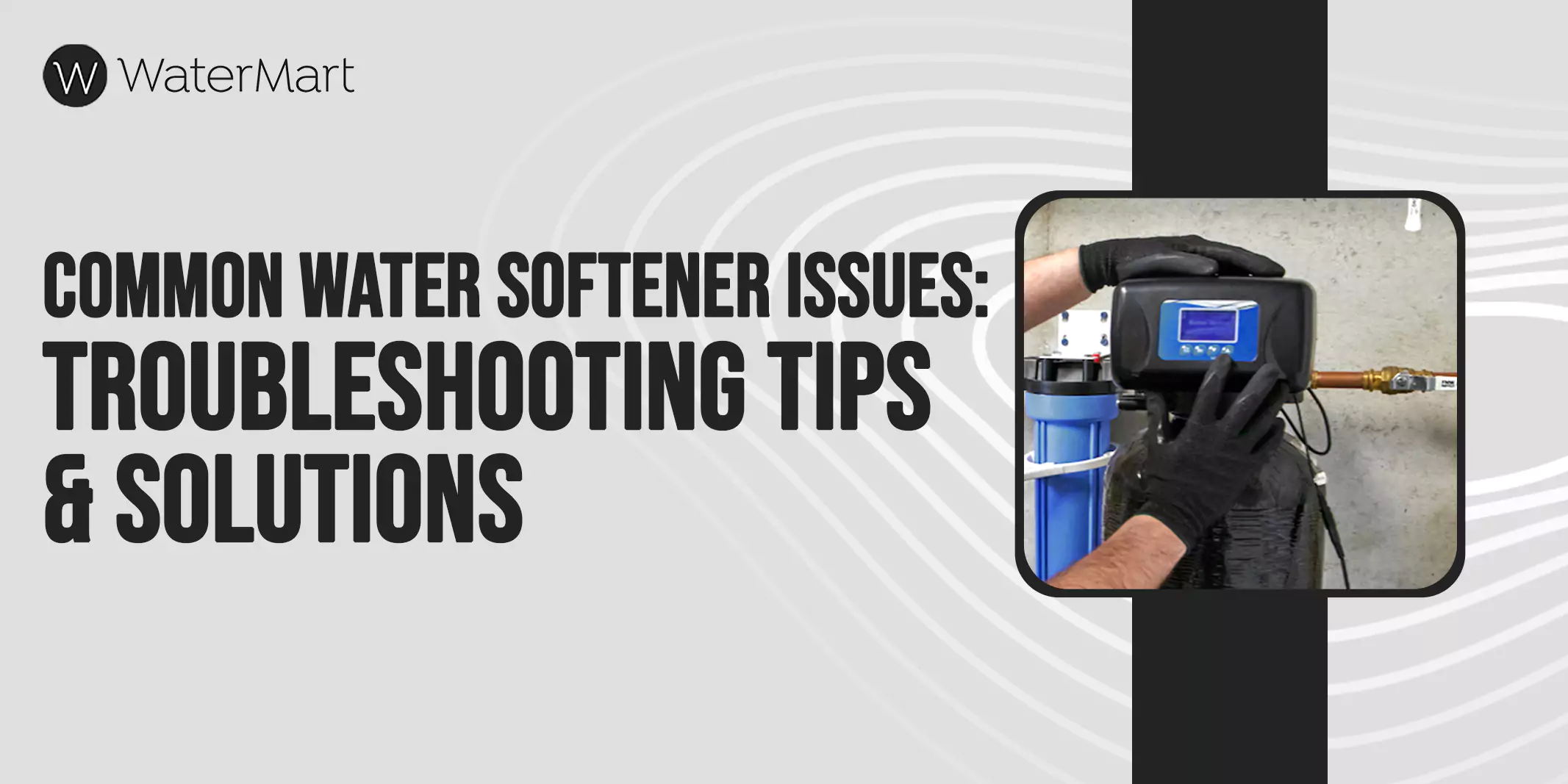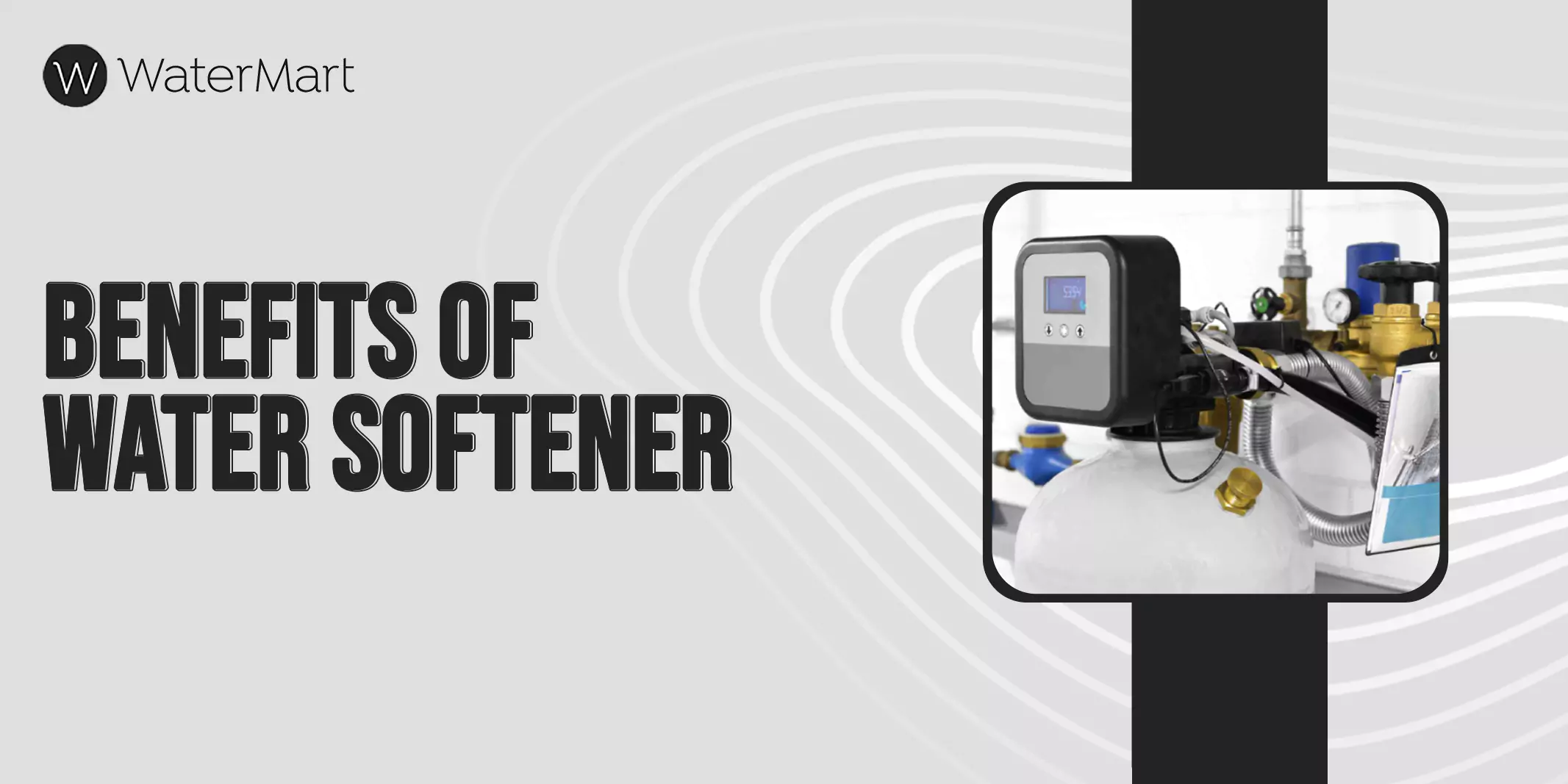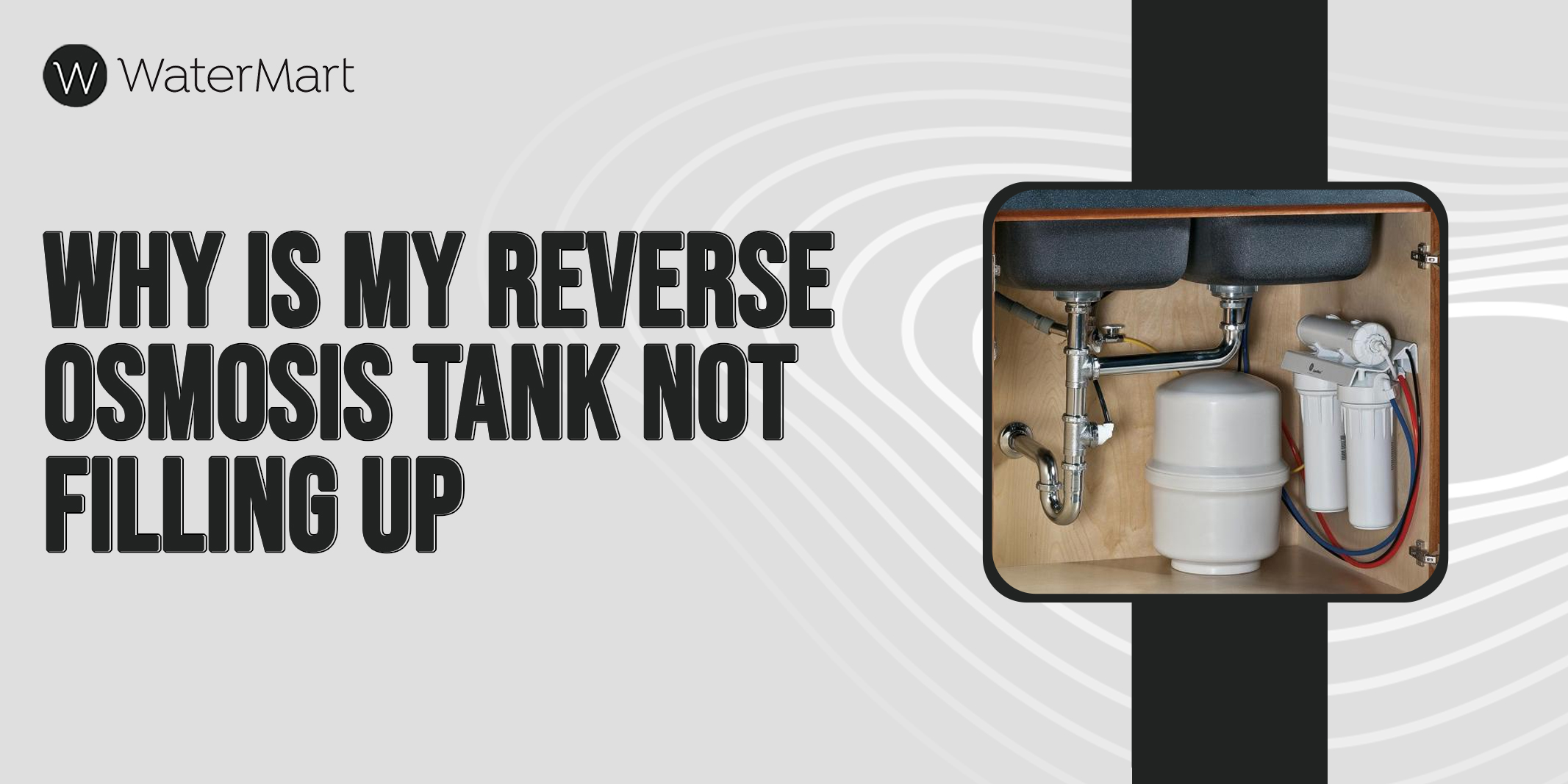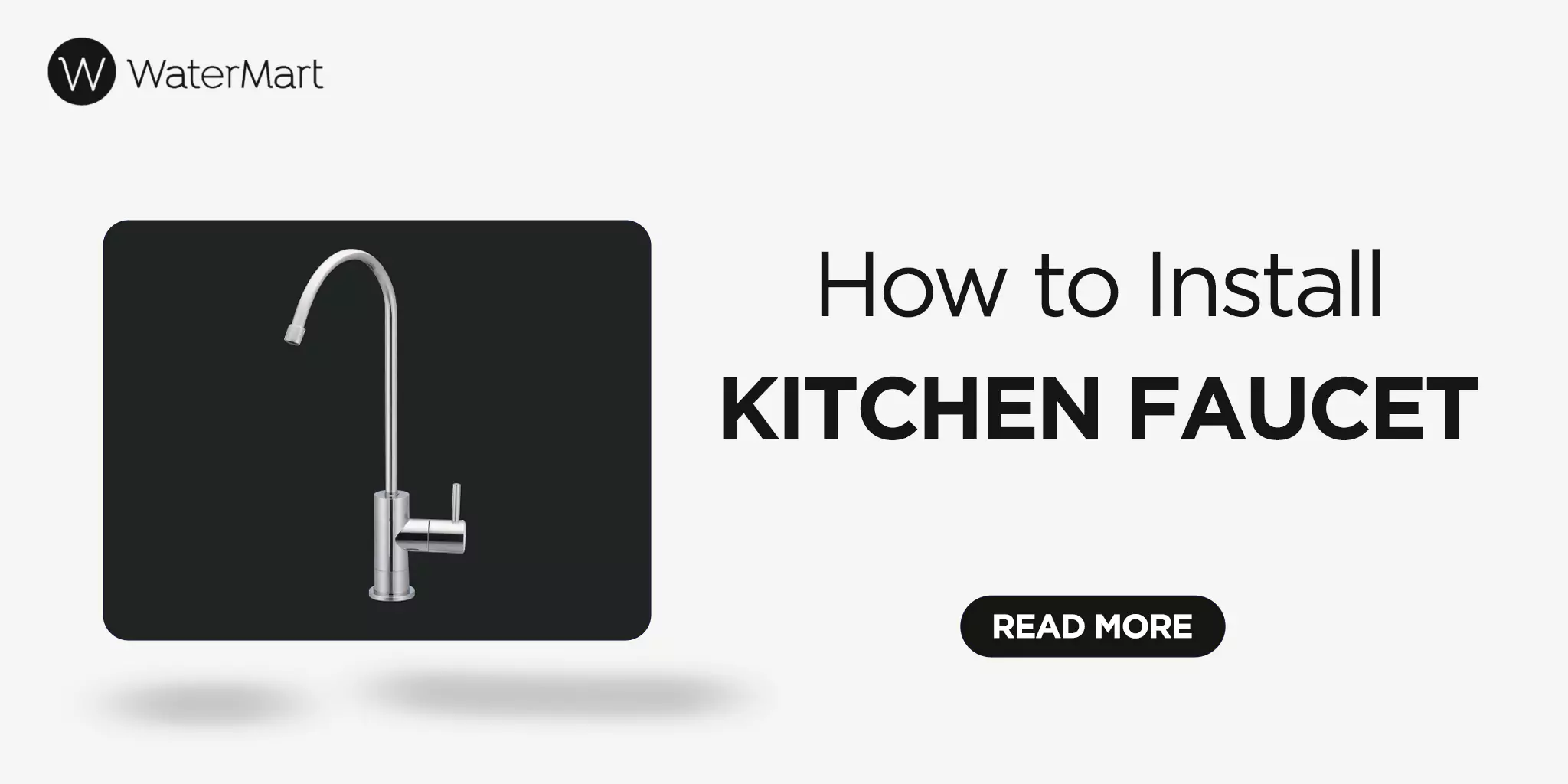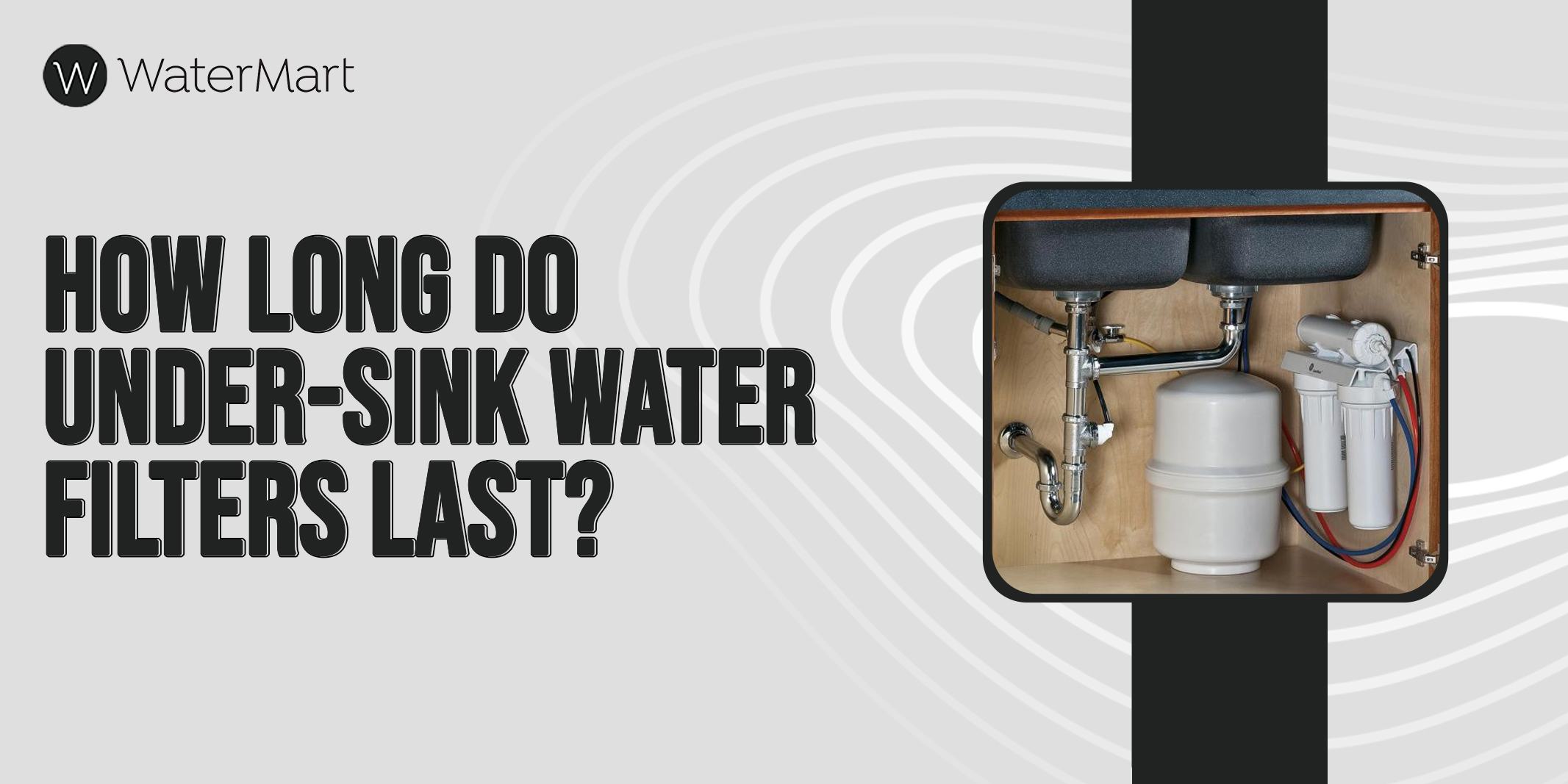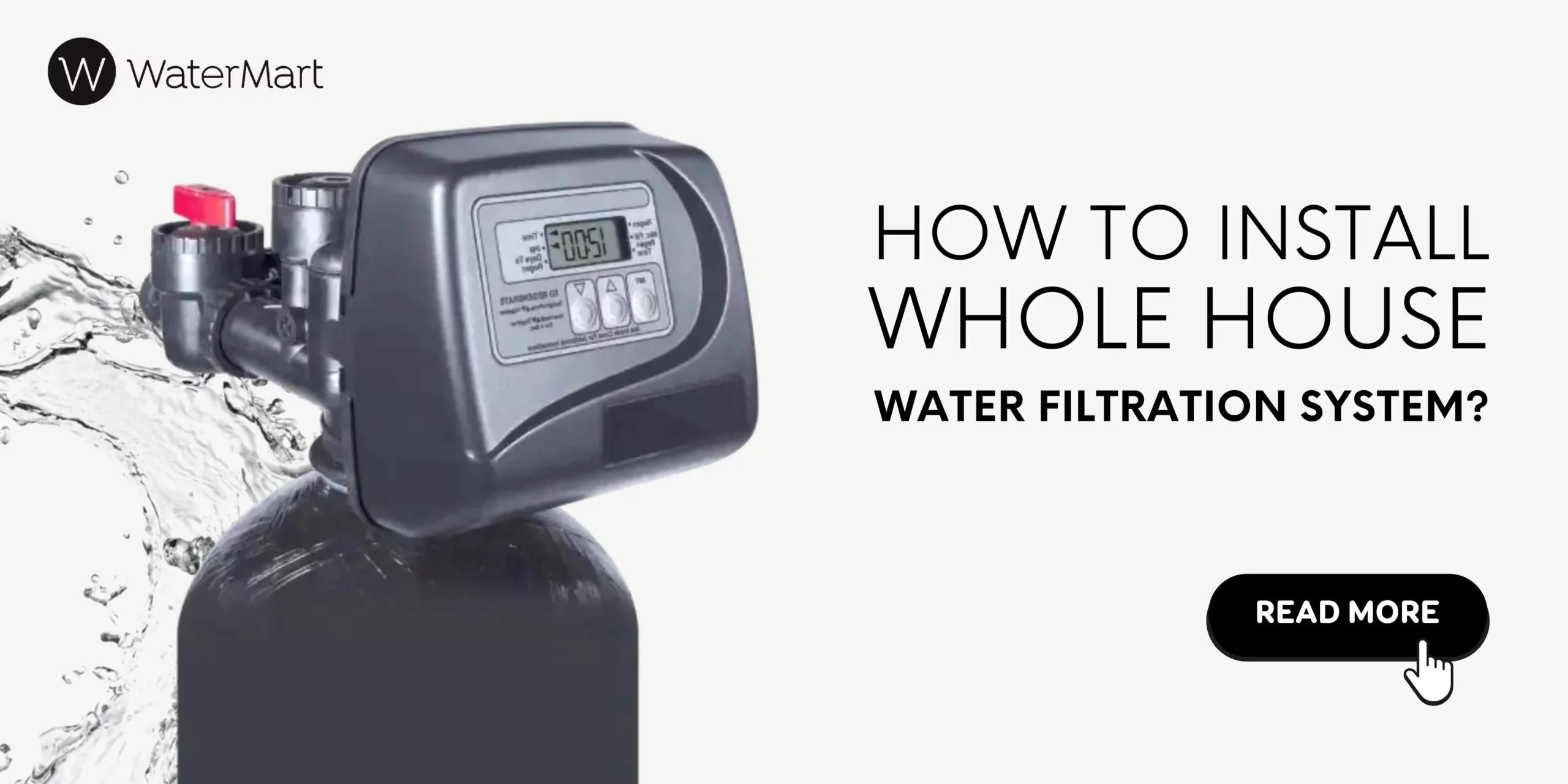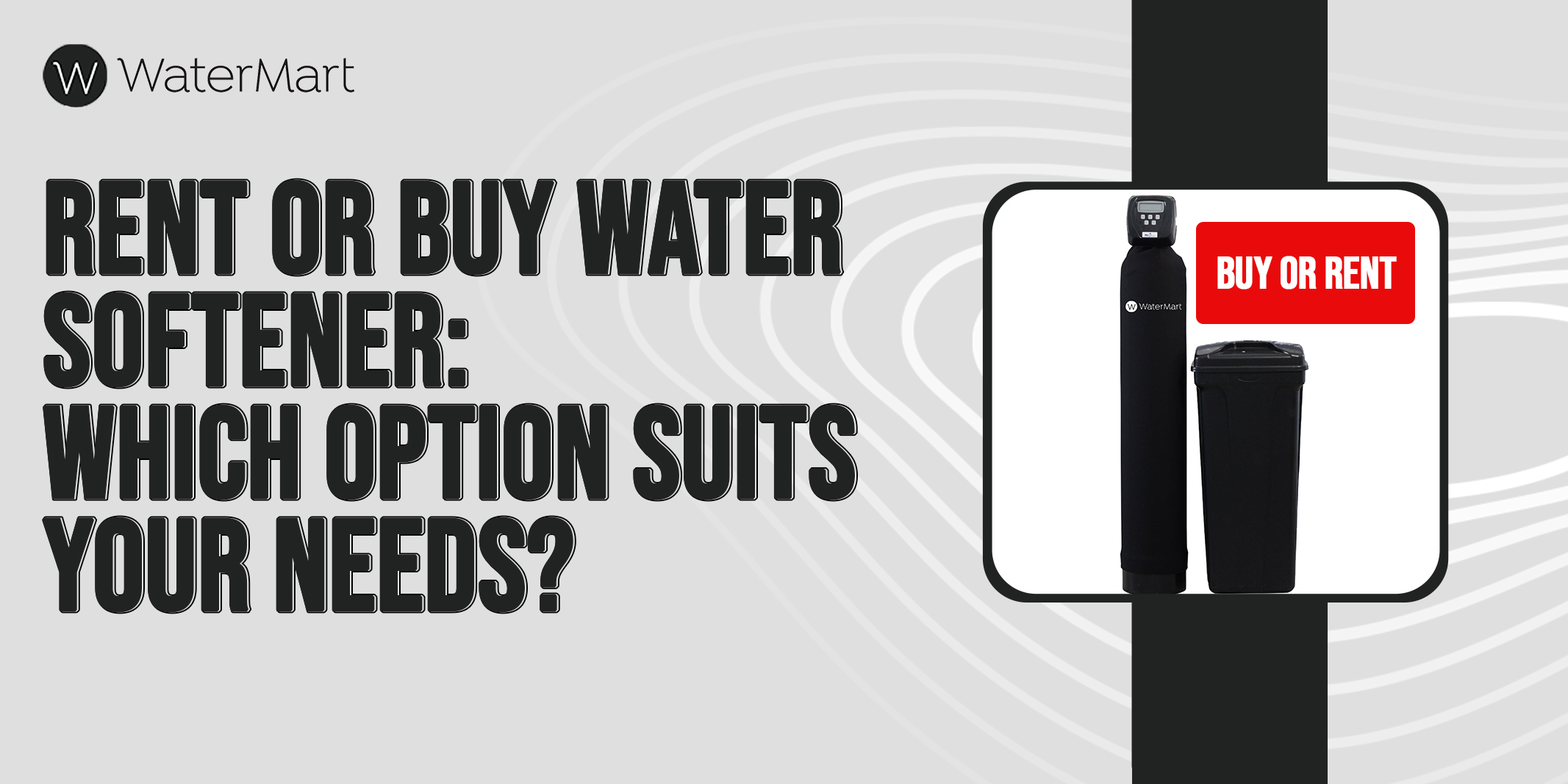Your cart is currently empty!
Common Water Softener Issues: Troubleshooting Tips & Solutions
If your water softener isn’t working properly, you need to fix it immediately.
Normally, water softeners last 15- 20 years if taken care of properly. Apparently, you can see if the systems are operating correctly, the controls are fine, and what the salt levels and their consumption. You can also see the resin beads visually and examine them to check the quality or the condition.
But what if you ignore underlying imperfections that bring irreplaceable damage to your water softeners? Or if the water pressure, capacity, or salt usage isn’t right? Yes, many factors can bring issues to your water softeners.
To cater to them all, you need to understand common water softener issues and their troubleshooting tips.
Want to get more details? Let’s continue understanding the common problems water softeners may have.
Common Symptoms of a Malfunctioning Water Softener
Common signs and symptoms of a malfunctioning water softener include getting hard water again in your tap water(at the point of use). You may get spotty dishes, leatherless soap, and detergents, white cast or scale build-up around your faucets and sanitary fixtures, and dry and damaged hair and skin.
At the softener’s end, there might be an increase in salt usage and a raised water hardness level, showing you a red flag. You may also notice a salt build-up in the brine tank solution or sludge at the bottom. Understanding each of the issues can help you know how to troubleshoot a water softener either at home or by calling an expert.
Common Water Softener Issues
There can be many issues that stop a water softener from working. The most common water softener issues include the softener not using salt, using too much salt, low water pressure, use of excessive water, or leakages. But, there can be other issues that are not visible but may impair water softeners. Here, we discuss all the issues one by one, along with their possible troubleshooting tips.
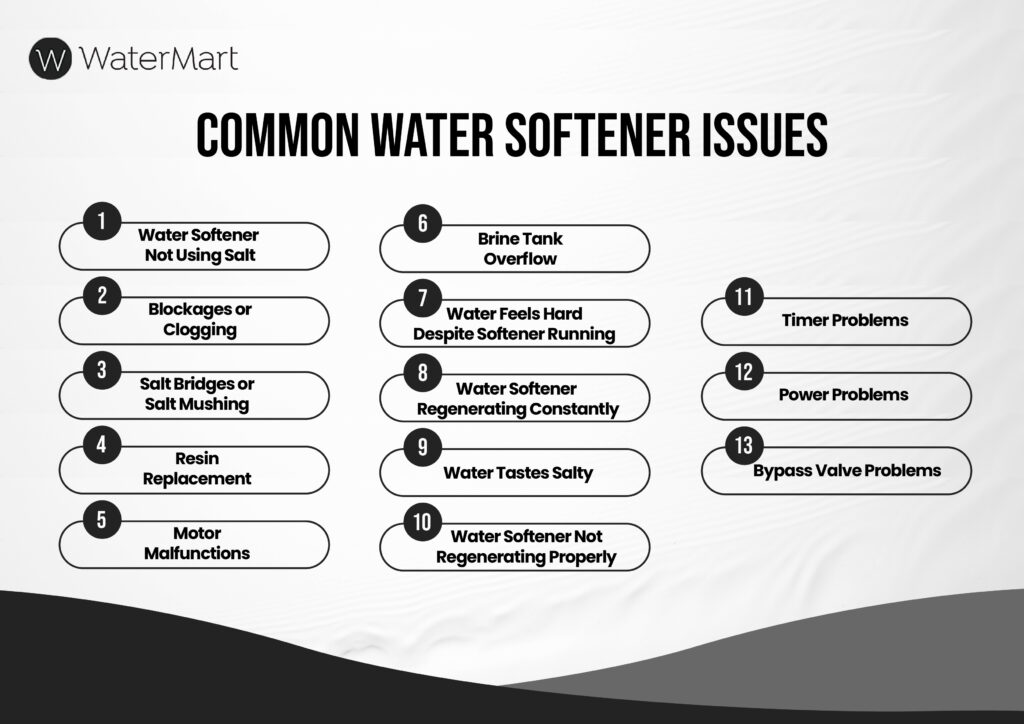
Water Softener Not Using Salt
- Look at the salt levels of your brine solution regularly. If your salt levels don’t drop for more than a week or two, it is a clear symptom that your softener is not using the salt. Your softener does not use the salt if:
- Salt Bridge Formation: There might be salt bridge formation in your brine solution tank. The crust does not let the salt dissolve in the water. Break the crust and remove the salt bridge to promote salt dissolution in the water.
- Clogging In Brine Line: The line that transfers brine solution from the brine tank to the water is called the brine line. Sometimes, the brine line is clogged, resulting in the prevention of salt usage and improper working ofthe softener. Check for the brine line clog and remove it. In case you can’t do it at home, call for professional help.
- Regeneration Settings: You might set low salt usage in your regeneration settings. If you have checked that all your hardware is working correctly, see your water softener regeneration settings and adjust the salt usage according to your water softener capacity needs.
- Salt Specifications: In case your salt type isn’t compatible with your softener or is too old, it will not take part in the regeneration process.
- Technical Malfunction: If you have checked for all the issues and haven’t spotted any of these, there might be some mechanical malfunction in your water softener. Check the softener’s hardware and look for mechanical malfunctioning, or call an expert at WaterMart, where we provide full technical support to handle all the problems and their solutions.
Blockages or Clogging
Blockages and clogging are a big cause of the softener’s improper working. The salt and mineral build-ups may block any lines that affect the regeneration process and the softener does not work.
Salt Bridges or Salt Mushing
Salt bridges are the formation of a solid salt crust on the top of the brine solution. It is hard and does not let the salt dissolve in water. Salt mushing is the recrystallization of salt at the bottom of the salt tank without letting it dissolve in the water. Salt bridges and salt mushing both are caused due to various factors, including humidity, temperature fluctuations, dissolution problems, unsuitable salt choices, and excessive salt build-ups. If you find such indications in your brine solution tank, remove the salt build-ups, wash the brine tank, and restart the process. If the problem persists, call an expert.
Resin Replacement
A salt softener may need a resin replacement every ten years. But sometimes you need the resin replacement earlier because of the high hardness levels of your water. Resin replacement may affect softeners working in the following ways:
- Delaying the resin replacement can prevent the water softener from working.
- Installing the wrong resin media may impact the water softener and its performance.
- An installation malfunction can create problems.
- Inadequate resin does not soften the water as per requirements.
- If the resin is not compatible with your water softener or the quality of the water, your softener may stop working.
You can check your resin and its replacement based on these factors to figure out the issue.
Motor Malfunctions
In water softeners, motors are responsible for supplying and controlling the water pressure and its flow. In case the motor fails, it cannot control the water supply, resulting in inadequate water softening, delaying regeneration, or system failure. In all these situations, inspect the motor and its functioning, wear and tear, and replace the motor or the affected parts.
Brine Tank Overflow
Brine tank overflow is a situation in which the brine solution overflows from the tank instead of going to the brine lines. It may be a reason because of clogging, blocked valves, or injectors, or stuck in the float switch. Visual inspection can indicate the reasons for tank overflow, and you can troubleshoot them accordingly.
Water Feels Hard Despite Softener Running
After running a softener smoothly and everything is working fine, you may get hard water in your household. Getting hard water in your taps means the resin beads are not working correctly and are unable to remove the hard minerals anymore. If it happens, check for the regeneration system and the cycle. You can run the regeneration process if you have an old softener or have set your settings on manual action. Once the regeneration takes place, check the hardness level of the water and see if the problem still exists or has gone away.
Water Softener Regenerating Constantly
Water softener regeneration runs continuously and does not stop because the system is stuck. The regeneration process stucks and keeps continuing because of malfunctioning control systems, including brine tank issues, control valve problems, or fluctuations in water pressure. Check for these problems and see if you can fix them at home, or calling a technician can solve this problem.
Water Tastes Salty
Your water may taste salty in your household faucets if the regeneration process is not working correctly. The problems may include issues appearing during the regeneration process, like salt build-ups, brine line blockage, improper salt settings, low water pressure, or clogged or dirty injectors. Checking for each issue and resolving what’s causing salty water can help you.
Water Softener Not Regenerating Properly
If you come across your regeneration process not working properly, look for reasons that stop a water softener from regenerating. There can be issues like low water pressure, system failure, blockages, clogs, salt bridges or salt mushing, malfunctioning of valves or injectors, improper functioning of resin media, or motor failures. Checking for these issues and getting them fixed can proceed the regeneration process once again.
Timer Problems
Modern softeners have built-in timers where you can set the frequency and the timing for the regeneration process. If the timer goes faulty, fails to work, or you have set the wrong timings, the regeneration process may stop working or may not work at all.
Power Problems
As the water softeners are run on electric power, any kind of power lag, power surge, outage, faulty power supply, low voltage problems, or power malfunction can lead to problems in the regeneration process. These problems affect the regeneration process, its timing, incomplete cycle, incorrect timer settings, and complete system failure.
Using protective switches, a backup battery, a voltage stabilizer, and regular maintenance of electric connections can save the water softener and keep its working functioning.
Bypass Valve Problems
Over time, bypass valves may leak, or their seals and gaskets may expire or stop working. Any leakage around the bypass valve is a clear indication of its condition. Inspection and replacement of faulty seals and valves can help you get your softener in working condition again.
How to Prevent Common Water Softener Issues
Once you see these problems, you can check and have an estimate of whether you can fix them at home or need professional help. To better understand the root of many water softener problems, it’s worth reviewing the differences between soft and hard water. But taking preventive measures regularly can help you avoid all these problems beforehand.
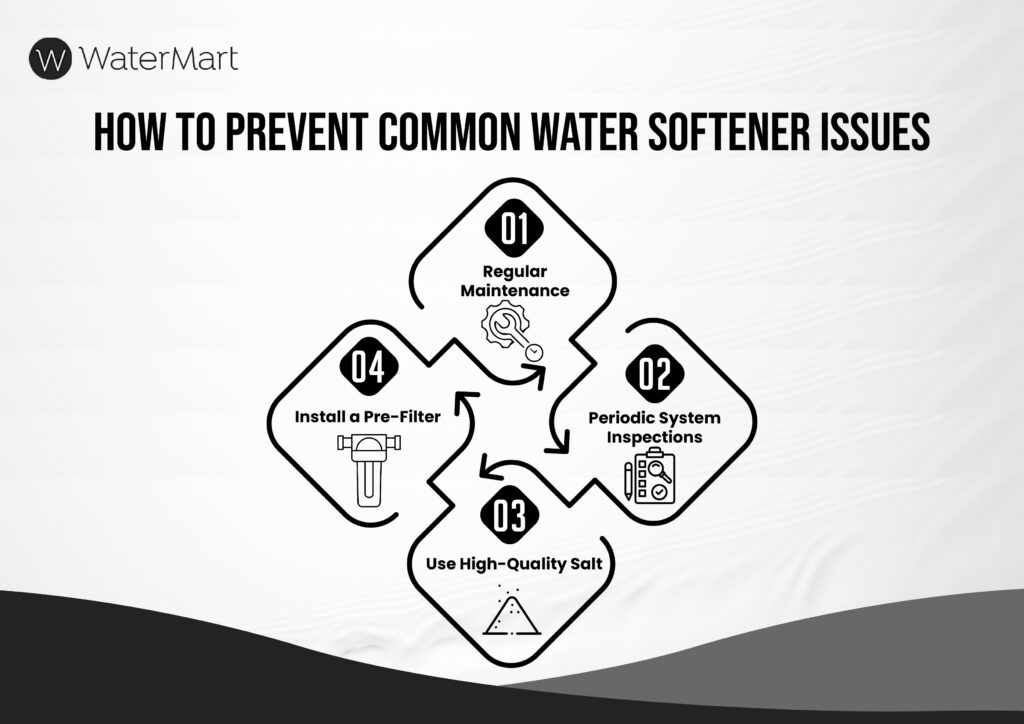
Regular Maintenance
Maintaining your water softener regularly requires special care. Keep an eye on salt levels, check the resin beads quality, figure out and remove any salt build-ups, keep the water pressure regulated, and check for the motor, valves, injectors, by-pass valve, and the control panel settings. If you see any of these factors malfunctioning, fix them on the spot to avoid any further inconvenience.
Periodic System Inspections
Periodic system inspection includes checking the water hardness on a regular basis to have an idea of any issues if present. Make a regimen and check all these parameters on a monthly basis.
- Regular monitoring and testing: the tests include
Water hardness testihttps://watermart.com/water-testing/ng
System checkups. - Check the salt quality and its level
Using the right salt is crucial. Check whether the salt being used is suitable or not.
Maintain the salt levels according to the recommendations. - Cleaning and Sanitation of the resin media and the water are necessary.
Check the resin bed and remove any build-ups of iron, silt, and organic compounds that reduce the resin’s functioning.
Sanitize the water periodically using anti-bacterial solutions approved for water softeners. - Seek Professional Help: Getting your water softener checked and maintained by professionals extends the softener’s life and helps you get professional help.
Professional inspection helps you get all the troubleshooting and preventive measures. You can contact us at WaterMart to get a water softener maintenance Service appointment.
Recording all the information in a journal and documentation keeps all the records that you may need in the hour of need. - Adjustment of Settings: Regular checking can help you adjust your settings accordingly.
Regeneration frequency can be changed if your water requirements change over time.
Setting customization can help you choose the amount of salt and regeneration frequency according to the hardness level of water.
Use High-Quality Salt
Using high-quality salt increases salt efficiency, speeds up the regeneration process, helps you decrease salt usage, and gives you large volumes of soft water. A low-quality salt is a waste of time, money, and effort that generates poor results.
Install a Pre-Filter
Installing a pre-filter can help you remove chlorine from the water. The water softener itself does not remove chlorine ( see our detailed article Does a Water Softener Remove Chlorine?), so it remains either in the system or goes to the household water. Installing a carbon-activated pre-filter increases the lifespan of your water softener and improves the water quality.
When to Call a Professional
Common water softener issues are softeners not using salt, low water pressure, salt bridges, salt mushes, and electrical or mechanical malfunctioning. Not all users are capable of handling such issues. If you have a technical background and can handle these issues, check your machine manuals and see for troubleshooting tips.
Anyhow, if you are new to water softeners and have no clue, simply turn off the switch and call a professional for help. You can either contact your water softener suppliers or contact us to get expert advice from our technicians.
We at WaterMart have trained staff with hands-on experience in installing and troubleshooting water treatment systems, including water softeners. Contact us today to discuss your water softener needs.
Conclusion
In Canada, water softeners have become an important household equipment as they provide you with soft water, remove hard minerals, and protect your sanitary, health, and other devices. But during their functioning, common water softener issues may appear.
If you keep a regular check and balance and look for the common issues and fix them in time, you can benefit from water softeners in the long run, without wasting your money.
Why Would A Water Softener Stop Working?
Your water softener may stop working if it is switched off, has blockages or clogging, or the resin beads are not regenerated. There may be issues with low salt levels, water pressure, and electrical or mechanical malfunctioning.
Why Is My Water Softener Not Treating The Water?
There are many reasons for water softeners not working. Lack of slat, presence of salt bridges and salt mushing, depleted resin, clogged or damaged valves, damaged venturi, broken or failed motor or timer. Look for each of the issues and fix them at home or call an expert.
How Can I Test If My Water Softener Is Working?
Use a water hardness test kit to check the before and after softening hardness levels of water. Also, if you feel improved soap leather and shining dishes, it means your water softener is working and producing soft water.
How Can You Tell If Your Water Softener Is Clogged?
See if your water softener is clogged by observing reduced water pressure, poor water flow, or if your water remains hard despite regeneration cycles. Also, check for salt buildup in the brine tank or blockages in the brine line and injector, which can indicate a clog.
How Long Do Water Softeners Usually Last?
Water softeners usually last for 15-20 years. Regular preventive maintenance can extend the life span up to 25 years.
What Happens When A Water Softener Fails?
It stops softening the water, and you get hard water in your household faucets.
